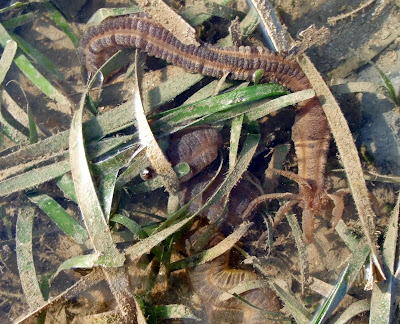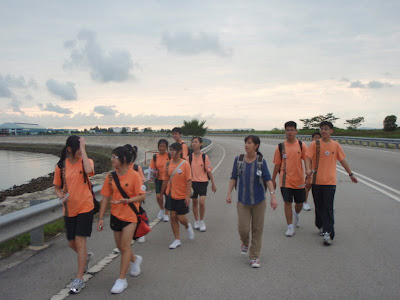Sixty Fourth Discovery Posting:
Today, as I was doing the job of hunter seeking at St. John's island, I was thinking about how to blog about this trip and it came to me that I have always been focusing more on the flora and fauna of the places I've been visiting rather than of things from a larger angle. Thus came the idea of this blog entry.
Why do I like to visit Singapore’s shores? Is it special?
"Singapore's shores are easy to get to! Uniquely Singapore! Where else in the world can a visitor quickly go from a high-level business meeting at a world class hotel to visit a living reef or mangrove? In under half an hour? The reefs of the Southern Islands are just 15 minutes away from the mainland by fast boat." (extract from Wildfilm's blog entry)Look (picture below), this was taken at St John's Island this morning without me using any optical zoom with my camera, so you can see how near you can be from our natural shores!
 Now let's turn our attention to the Great Barrier Reef a while for some figures. Studies has concluded that there are about 400 species of hard corals there. You might wonder why am I bringing up the Great Barrier Reef when knowing that the amount of reef area we have in Singapore is not even 0.1% compared to the Great Barrier Reef.
Now let's turn our attention to the Great Barrier Reef a while for some figures. Studies has concluded that there are about 400 species of hard corals there. You might wonder why am I bringing up the Great Barrier Reef when knowing that the amount of reef area we have in Singapore is not even 0.1% compared to the Great Barrier Reef.Well. Below's a figure which might capture your attention.
"The reefs in Singapore harbour close to 200 species of hard corals, which given the size of the reefs and conditions present here, compare favourably with coral species richness in the more extensive reefs of the region" (extract from the Coral Reefs of Singapore website, Reef Ecology Study Team, NUS)
Some photos of corals from St. John's Island below



 Now, you might be thinking, Wow! Two hundred species compared to four hundred! This should be make known to all (the idea behind this discovery blog entry)! One might even say this is a neglected heritage of Singapore, as written by Liana recently on the Straits Times.
Now, you might be thinking, Wow! Two hundred species compared to four hundred! This should be make known to all (the idea behind this discovery blog entry)! One might even say this is a neglected heritage of Singapore, as written by Liana recently on the Straits Times.Extra:
Click here to read the article online on the wildsingapore's news blog.
So now, you might wonder,
Can I experience Singapore’s marine heritage without much hassle?
In fact, the answer to this question is a YES!
“No need to swim, no need to dive! Many volunteer groups provide guided walks on boardwalks and low tide walks for ordinary people. An ideal trip for the family, bring grandma and the little kids!. " (extract from Wildfilm's blog entry)
Of course, do bear in mind that you will get your feet wet for low-tide walks. Well. But isn't that part of the fun of visiting a shore? =)
What can I see at these place? Just corals?
Well, not just corals. For this part, i would say pictures are worth a thousand words =)
Below are a peek of some things which I saw during my trips to St. John recently...
A flatworm (picture below)
 Brittle star (picture below)
Brittle star (picture below) A sea snail with a beautiful shell (picture below).
A sea snail with a beautiful shell (picture below). And if you read my other discovery blog entries, you will discover many other things one can find on our shores.
And if you read my other discovery blog entries, you will discover many other things one can find on our shores.Extra:
a) Free photos of flora and fauna one can find on Singapore's shores. Download them to be your desktop picture. Click here to get them!
b) Click here to find out more about our reefs on the blog for International Year of the Reefs 2008!
By now, you might be very tempted to pay a visit to our shores, so here's some information (below) to help you to discover our wonderful shores!
Raffles Museum of Biodiversity Research (NUS)
Conducts guided walks at Pulau Semakau and workshops for schools on our shores.
http://rmbr.nus.edu.sg/
Chek Jawa (NParks)
Conducts guided walks on the shores of Chek Jawa.
http://www.nparks.gov.sg
Blue Water Volunteers
Conducts guided walks at Kusu Island, underwater reef surveys and guided dives at Singapore’s reefs, as well as outreach through talks and exhibitions.
http://www.bluewatervolunteers.org
TeamSeagrass (with NParks)
Monitors the seagrass meadows at 6 locations as well as outreach through talks and exhibitions.
http://teamseagrass.blogspot.com
Naked Hermit Crabs
Conducts guided walks at the Chek Jawa boardwalk every month, and family walks at Sentosa’s natural shores during the school holidays as well as outreach through talks and exhibitions.
http://nakedhermitcrabs.blogspot.com
Sungei Buloh Wetland Reserve (NParks) about 40 volunteers
Conducts guided walks at the Reserve
http://www.sbwr.org
Hantu Bloggers
Conducts guided dives at Pulau Hantu as well as outreach through talks and exhibitions.
http://www.pulauhantu.org























